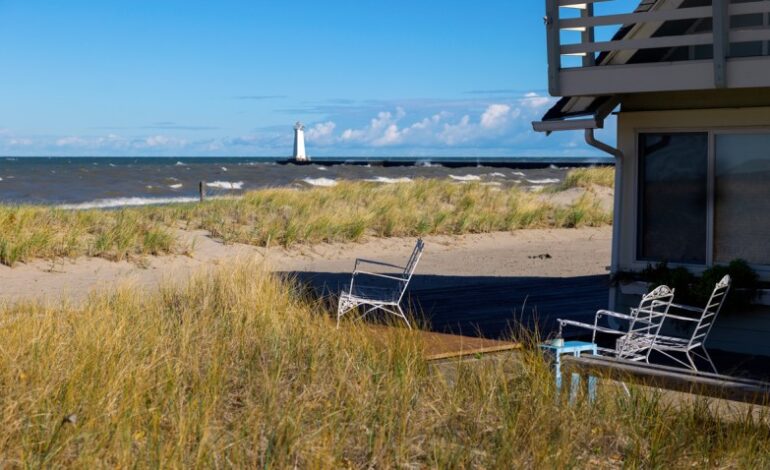Sodus Point Dune Restoration Plan Moves Forward with NY Sea Grant

Officials in Sodus Point, New York, are set to restore a significant coastal dune that has grown excessively over the past two years. The dune, constructed in 2021 as a protective measure following severe flooding in 2017 and 2019, has expanded to the point where some residents have lost their view of Lake Ontario. The village’s inability to maintain the dune, compounded by staff turnover, led to growing tensions between residents and local authorities regarding its upkeep.
In July 2023, the village sought assistance from New York Sea Grant (NYSG), a collaborative research and extension program associated with Cornell University and the State University of New York. Over ten weeks, NYSG’s specialists, Mary Austerman and Roy Widrig, facilitated discussions with affected homeowners and coordinated efforts with local government and environmental agencies. Their aim was to clarify responsibilities and develop a new maintenance plan for the dune.
Community Engagement and Collaborative Solutions
As part of their outreach, Austerman and Widrig conducted public meetings and individual consultations, helping residents voice their concerns. “There were a lot of miscommunications around what property owners could do, and what the village was supposed to be doing,” said Kevin Druschel, the village’s code enforcement officer and project manager for the dune restoration. “The dune was supposed to be a great thing, and it became a bad thing.”
With a new permit obtained from the New York State Department of Environmental Conservation (NYSDEC), the village plans to realign the dune with its original specifications. Maintenance is scheduled to commence on November 6, 2023. For their efforts in mediating the situation, Austerman and Widrig received an Assembly Citation from Brian Manktelow, the New York State Assemblyman for the 130th District. Druschel acknowledged the critical role NYSG played in the project, stating, “I don’t know that we would have been able to do what we did without Sea Grant.”
Austerman described the collaborative effort as “textbook extension work,” emphasizing the importance of unbiased facilitation in complex community matters. “The village was down capacity-wise… so we brought an unbiased ability to cut through the frustrations and get the project back on track,” she said.
Historical Context and Future Outlook
Sodus Point, situated at the lowest elevation on the south side of Lake Ontario, faced severe flooding in 2017 and 2019, prompting the construction of the dune. The community had previously taken drastic measures, including sandbagging and operating industrial pumps around the clock, to prevent water from inundating roads and properties. Despite these efforts, significant damage occurred, highlighting the necessity of effective coastal management.
“The waves kept coming in,” recalled neighborhood resident Laurie Hayden, describing the storms of 2019. “When I was standing on my deck, it appeared that I was floating on the lake.” Following these events, NYSG assisted the village in developing strategies for flood mitigation, including the construction of the dune, which has since been recognized by the American Shore and Beach Preservation Association.
While the dune has proven beneficial in dissipating storm energy and preventing flooding, it has also come with maintenance regulations that were not consistently enforced due to staffing changes within the village government. As a result, the dune grew larger than intended, leading to confusion over its management.
In their initial meetings, Austerman and Widrig encountered frustration from residents who felt disconnected from the decision-making process. “Some of the residents said they’d never seen the maintenance plan and as a result did nothing to maintain the dune out of fear of doing the wrong thing,” Austerman noted. Her and Widrig’s role was pivotal in educating both residents and local officials about the ecological significance of the dune.
“I’m a highway and bridge guy; I didn’t know anything about dunes,” said Kevin Rooney, Superintendent for the Wayne County Highway Department, which will oversee the upcoming maintenance. “Mary and Roy are super facilitators, and they bring their experience to the table. Now I understand what a dune is supposed to do, why it’s been constructed, and why you have to bow down to the dune – it’s that important and that environmentally sensitive.”
Beginning on November 6, the village and county will strategically remove excess sand from the dune’s base and dismantle unnecessary fencing. This approach aims to allow the dune to “relax” and reduce its height. Druschel expressed optimism for the project’s future, stating, “We’re really hoping that this is the best approach to get us back on track. From now on, the dune will continue to change – growing and shrinking over time – it’s going to be a living, breathing dune from now on, and it’s going to be maintained the way it’s supposed to be.”






